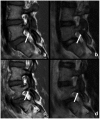Confidence in Assessment of Lumbar Spondylolysis Using Three-Dimensional Volumetric T2-Weighted MRI Compared With Limited Field of View, Decreased-Dose CT
- PMID: 27282808
- PMCID: PMC4922525
- DOI: 10.1177/1941738116653587
Confidence in Assessment of Lumbar Spondylolysis Using Three-Dimensional Volumetric T2-Weighted MRI Compared With Limited Field of View, Decreased-Dose CT
Abstract
Background: Limited z-axis-coverage computed tomography (CT) to evaluate for pediatric lumbar spondylolysis, altering the technique such that the dose to the patient is comparable or lower than radiographs, is currently used at our institution. The objective of the study was to determine whether volumetric 3-dimensional fast spin echo magnetic resonance imaging (3D MRI) can provide equal or greater diagnostic accuracy compared with limited CT in the diagnosis of pediatric lumbar spondylolysis without ionizing radiation.
Hypothesis: Volumetric 3D MRI can provide equal or greater diagnostic accuracy compared with low-dose CT for pediatric lumbar spondylolysis without ionizing radiation.
Study design: Clinical review.
Level of evidence: Level 2.
Methods: Three pediatric neuroradiologists evaluated 2-dimensional (2D) MRI, 2D + 3D MRI, and limited CT examinations in 42 pediatric patients who obtained imaging for low back pain and suspected spondylolysis. As there is no gold standard for the diagnosis of spondylolysis besides surgery, interobserver agreement and degree of confidence were compared to determine which modality is preferable.
Results: Decreased-dose CT provided a greater level of agreement than 2D MRI and 2D + 3D MRI. The kappa for rater agreement with 2D MRI, 2D + 3D MRI, and CT was 0.19, 0.32, and 1.0, respectively. All raters agreed in 31%, 40%, and 100% of cases with 2D MRI, 2D + 3D MRI, and CT. Lack of confidence was significantly lower with CT (0%) than with 2D MRI (30%) and 2D + 3D MRI (25%).
Conclusion: For diagnosing spondylolysis, radiologist agreement and confidence trended toward improvement with the addition of a volumetric 3D MRI sequence to standard 2D MRI sequences compared with 2D MRI alone; however, agreement and confidence remain significantly greater using decreased-dose CT when compared with either MRI acquisition.
Clinical relevance: Decreased-dose CT of the lumbar spine remains the optimal examination to confirm a high suspicion of spondylolysis, with dose essentially equivalent to radiographs. If clinical symptoms are not classic for spondylolysis, 2D MRI is still very good at detecting spondylolysis while remaining sensitive for detection of alternative diagnoses such as disc abnormalities and pars stress reaction. The data suggest that standard 2D MRI sequences should not be entirely replaced by a volumetric T2-weighted 3D sequence (despite promising features of rapid acquisition time, increased spatial resolution, and reconstruction capability).
Keywords: 2D MRI; 3D MRI; CT; spondylolysis; volumetric.
© 2016 The Author(s).
Conflict of interest statement
The authors report no potential conflicts of interest in the development and publication of this article.
Figures






References
-
- Amato M, Totty WG, Gilula LA. Spondylolysis of the lumbar spine: demonstration of defects and laminal fragmentation. Radiology. 1984;153:627-629. - PubMed
-
- Blizzard DJ, Haims AH, Lischuk AW, Arunakul R, Hustedt JW, Grauer JN. 3D-FSE isotropic MRI of the lumbar spine: novel application of an existing technology. J Spinal Disord Tech. 2015;28:152-157. - PubMed
-
- European Guidelines on Quality Criteria for Computed Tomography. Luxembourg: European Commission’s Radiation Protection Actions; 2000.
-
- Fadell MF, Gralla J, Bercha I, et al. CT outperforms radiographs at a comparable radiation dose in the assessment for spondylolysis. Pediatr Radiol. 2015;45:1026-1030. - PubMed
-
- Fleiss JL, Levin B, Cho Paik M. Statistical Methods for Rates and Proportions. 3rd ed. New York, NY: Wiley; 2003.
MeSH terms
LinkOut - more resources
Full Text Sources
Other Literature Sources
Medical
Research Materials
Miscellaneous

